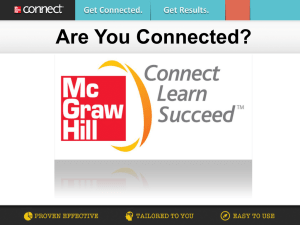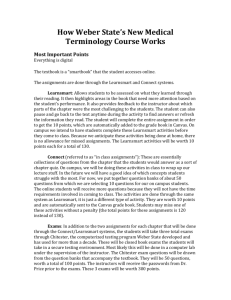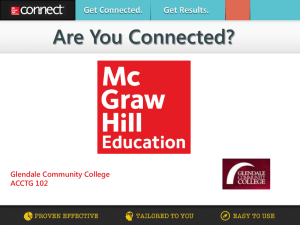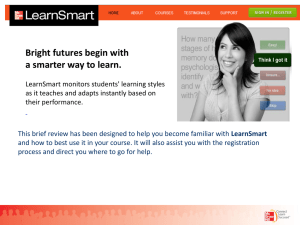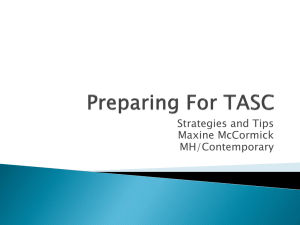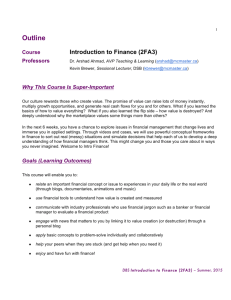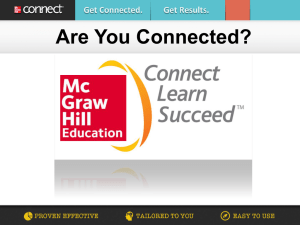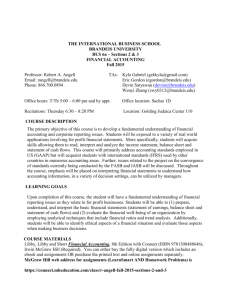McGraw-Hill LearnSmart Effectiveness Study
advertisement
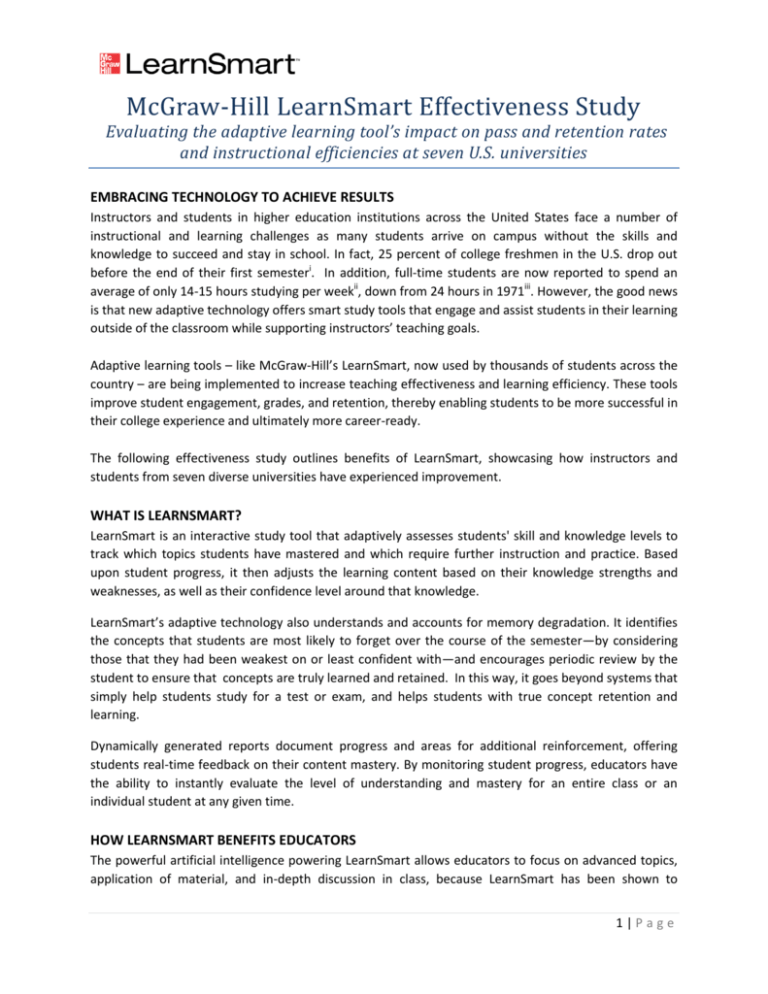
McGraw-Hill LearnSmart Effectiveness Study Evaluating the adaptive learning tool’s impact on pass and retention rates and instructional efficiencies at seven U.S. universities EMBRACING TECHNOLOGY TO ACHIEVE RESULTS Instructors and students in higher education institutions across the United States face a number of instructional and learning challenges as many students arrive on campus without the skills and knowledge to succeed and stay in school. In fact, 25 percent of college freshmen in the U.S. drop out before the end of their first semesteri. In addition, full-time students are now reported to spend an average of only 14-15 hours studying per weekii, down from 24 hours in 1971iii. However, the good news is that new adaptive technology offers smart study tools that engage and assist students in their learning outside of the classroom while supporting instructors’ teaching goals. Adaptive learning tools – like McGraw-Hill’s LearnSmart, now used by thousands of students across the country – are being implemented to increase teaching effectiveness and learning efficiency. These tools improve student engagement, grades, and retention, thereby enabling students to be more successful in their college experience and ultimately more career-ready. The following effectiveness study outlines benefits of LearnSmart, showcasing how instructors and students from seven diverse universities have experienced improvement. WHAT IS LEARNSMART? LearnSmart is an interactive study tool that adaptively assesses students' skill and knowledge levels to track which topics students have mastered and which require further instruction and practice. Based upon student progress, it then adjusts the learning content based on their knowledge strengths and weaknesses, as well as their confidence level around that knowledge. LearnSmart’s adaptive technology also understands and accounts for memory degradation. It identifies the concepts that students are most likely to forget over the course of the semester—by considering those that they had been weakest on or least confident with—and encourages periodic review by the student to ensure that concepts are truly learned and retained. In this way, it goes beyond systems that simply help students study for a test or exam, and helps students with true concept retention and learning. Dynamically generated reports document progress and areas for additional reinforcement, offering students real-time feedback on their content mastery. By monitoring student progress, educators have the ability to instantly evaluate the level of understanding and mastery for an entire class or an individual student at any given time. HOW LEARNSMART BENEFITS EDUCATORS The powerful artificial intelligence powering LearnSmart allows educators to focus on advanced topics, application of material, and in-depth discussion in class, because LearnSmart has been shown to 1|Page improve students’ class and test preparation outside of the classroom. In disciplines as diverse as Psychology, Anatomy & Physiology, Accounting and Management, educators have reported that LearnSmart allows them to refocus on teaching by providing them an effective method to ensure students spend the necessary time and effort learning core course content outside of the classroom – whether basic content previously covered in lecture or content students are seeing for the first time. More effective teaching LearnSmart guides students – at their own pace and on their own time – through the basic knowledge and skills covered in a course, so that they come to each class with a solid foundation of concepts that will be covered. For professors like Paul W. Thurston, Ph.D., assistant professor of marketing and management at Siena College, who strive to have students An independent study of students attend class prepared to discuss the assigned material, studying Anatomy & Physiology I at community colleges found that students LearnSmart is invaluable. In his Organization & using LearnSmart see significant Management class, Thurston found “students who were improvements in pass rates (+12.5 engaged in the online LearnSmart modules participating percentage points) and in retention rates more and performing better on quizzes and in class (+10.5 percentage points). projects.” When students come to class prepared, instructors can cover more advanced topics and have time for more facilitated classroom discussion, critical thinking and practical application assignments, which all lead to deeper student engagement. Professor Thomas Norman, who teaches Management at California State University, Dominguez Hills, requires students to complete the LearnSmart learning modules correlated to the following week’s content “I spend class time reviewing on the Sunday prior to the content areas in which lecture. This allows him students have the most to use the LearnSmart difficulty in LearnSmart. I skip reports to provide a several sections where the snapshot analysis of mastery is quite high.” student performance on -Professor Thomas Norman, the assigned topics, and California State University, then adapt his lecture Dominguez Hills based upon his overall class knowledge. As a result, he can now ensure all required topics are covered in his course while reducing time spent in lecture to only those hard-to-master concepts. Not having to lecture on all of the assigned content has allowed him to cover more applied topics and real-world activities in class, including mock interviews and experiments while getting through the required course curriculum. 2|Page Professors who require LearnSmart in their classes tend to see significant improvements in student pass and retention rates, as well as performance in the course, as compared with students from prior terms without LearnSmart or more traditional static review assignments, such as from the textbook test bank. An independent study of over 700 students studying Anatomy & Physiology I at six distinct institutions across the country found that students using LearnSmart increased their performance in the course. As seen in Figure 1, students increased their grade by one full letter, with more B students getting As, and more C students getting Bs. An independent study of over 700 students studying Anatomy & Physiology I at 6 distinct institutions across the country found that students experience greater success when LearnSmart is required. More B students improve their learning and earn A’s; and more C students get B’s. Exp B C D F D F Group A Contr ol A 0% 10% B 20% 30% 40% C 50% 60% 70% 80% 90% 100% Percentage Experimental n=358 Control n=334 In addition, community colleges participating in the study reported significant improvements in average pass rates (+12.5 percentage points) and in retention rates (+10.5 percentage points). Supporting all learners LearnSmart’s dynamically generated reports give educators the ability to understand the strengths and weaknesses of individual students. This information can prove invaluable in helping educators identify the students that may otherwise fall behind in a course before it is too late, providing instructors the information needed to offer timely assistance to help ensure the student stays in the course. Connect with LearnSmart has helped engage the learner in a way I didn’t think was possible. It has also helped me to be a more reflective teacher and pinpoint class issues with a topic.” -Professor Frank Wray, University of Cincinnati 3|Page Indeed, respected educators such as Professor William Hoover, M.D., assistant professor of science and engineering at Bunker Hill Community College, have endorsed LearnSmart with making a life-changing impact on some of his students. A recent nursing school graduate credits LearnSmart and Hoover’s Anatomy & Physiology class with putting her on her chosen Fall 2009 career path. Early in Hoover’s course, she was falling behind. Students on average Had she waited for the midterms to get feedback, she most performed 10.24 points higher likely would have failed the course, and dropped out altogether. on all exams as compared to The real-time feedback allowed her to identify her weaknesses those who did not use and get targeted help from Hoover from the start, which in turn LearnSmart. kept her motivated, graduating at the top of her class, and 100 ultimately succeeding in her career. 90 While having such a life-changing impact on a student may be rare, LearnSmart can also assist educators in improving overall scores. Many instructors have found that the more LearnSmart modules students completed, the greater their success and retention of learned knowledge. Results from New Mexico State University show students who completed all the LearnSmart modules scored an average of 10 percent higher on all exams as compared with those students who did not use LearnSmart. 80 70 60 50 40 30 20 10 HOW LEARNSMART BENEFITS STUDENTS Students also benefit greatly from LearnSmart. Using LearnSmart to study has proven to lead to improved learning efficiency, greater engagement, and better career readiness. Learning efficiency With its ability to pinpoint a student’s knowledge gaps and direct the student to the exact section of the eBook or textbook content for reinforcement, LearnSmart personalizes the study environment based on student needs. Students appreciate LearnSmart’s ability to focus their attention on the areas where they need to spend the most time, resulting in more efficient study time for today’s student and increased readiness for lecture and exams. 0 Test 1 Test 2 Test 3 Test 4 0-0.5 modules 1-1.5 modules 2-2.5 modules 3-3.5 modules 4 modules “LearnSmart helps me focus on the main topics in each chapter. Also, I love how it recognizes when I am not understanding a concept and provides the specific text for me to study. It is extremely helpful.” -Student, University of Louisiana at Lafayette As students work through each module, LearnSmart assesses how confident they are about their answers. Metacognitive reports generated by LearnSmart show students how comfortable they are with what they’ve learned, so even if they have shown mastery but are not confident about it, LearnSmart will provide them continued practice until they’ve reached full confidence in their content mastery. 4|Page Student engagement When students complete LearnSmart modules before class, they are knowledgeable about core course content and, as a result, are more engaged in classroom discussion and participation. Students are asking higher-level questions, spiking greater interaction with and interest in the subject matter, while instructors are able to spend valuable class time covering more advanced topics in higher levels of the cognitive domain. “The LearnSmart system stuff helped A LOT. I would say that if you want to pass the class, you need to do those. They helped me remember things I otherwise wouldn’t have known on the test. Thank you so much!” -Student, New Mexico State University Many students also find LearnSmart fun, “playing” against fellow students and comparing who knows the most. This friendly competition and way of learning makes studying feel like anything but the stereotype of cramming. As the Biology Department Chair at Amarillo College, Professor Michael Kopenits finds that students are now more willing to do work outside of the classroom. Greater engagement coupled with greater efficiency leads to greater results, and Kopenits has seen increased classroom performance and interest/motivation by one-half to a full letter grade. Career readiness Reaching higher levels of the cognitive domain and covering more advanced topics leads not only to more knowledge, but a better assimilation of that knowledge. This means that students are better prepared for their careers than students who do not use LearnSmart. Students don’t just go through the motions to get the required credits to graduate. They integrate the course materials better, at a much higher level of comprehension, and with higher retention of knowledge. In sum, they are better prepared for the professional world. “Thanks to you, professor, I will be able to give my two children a future” -Student, Bunker Hill Community College CONCLUSION This analysis of student performance confirms what instructors and students have been anecdotally suggesting: LearnSmart demonstrably helps students learn while supporting instructors as they teach. Based on research conducted in a variety of classes at a diverse range of universities, it’s clear that adaptive learning tools increase teaching effectiveness and learning efficiency for all types of instructors and students. By utilizing adaptive learning tools like McGraw-Hill’s LearnSmart, higher education institutions across the country can improve student engagement, retention and grades, building a graduating class that is more prepared for the workforce. For more information on LearnSmart, please visit www.mhhe.com/learnsmart. Methodology: The LearnSmart effectiveness study is based on findings from seven independent studies conducted by instructors using LearnSmart in their classes and an independent study of over 700 students studying Anatomy & Physiology I at six distinct institutions. While the studies were carried out independently from one another and present variations in the way data was gathered and analyzed, they all measure changes in grades and/or test scores between sample and test groups. Due to these variations in the methodology, there is no way of measuring an average rate of improvement from the various studies. Yet in every case, studies of the effectiveness of LearnSmart suggest an improvement in learning and teaching efficiencies. 5|Page i The Governance Divide: A Report on a Four‐State Study on Improving College Readiness and Success, a report conducted and issued by: the Institute for Education Leadership, the National Center for Public Policy and Higher Education, and the Stanford Institute for Higher Education Research, 2005 ii Major Differences: Examining Student Engagement by Field of Study, a National Survey of Student Engagement report conducted and issued by Indiana University Center for Postsecondary Research, 2010 iii Leisure College, USA: The Decline in Student Study Time, a report by Philip Babcock and Mindy Marks for the American Enterprise Institute for Public Policy Research, Education Outlook, No. 7, August 2010 6|Page
